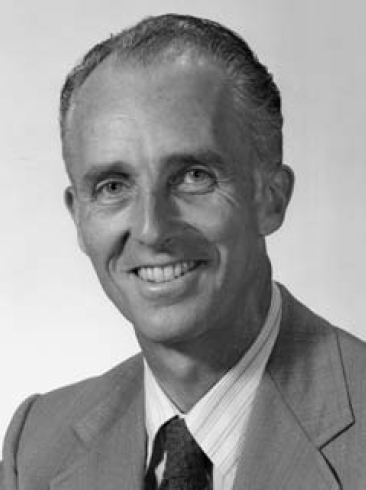
1920–2010
Elected in 1974
“For leadership in the design and production of the Apollo Lunar Module.”
BY NEIL ARMSTRONG
JOSEPH G. GAVIN, JR., a highly regarded aerospace engineer and former president, chief operating officer, and director of the Grumman Corporation died on October 30, 2010, at age 90.
Joe was born in Somerville, Massachusetts, on September 18, 1920. He earned bachelor’s and master’s degrees in aeronautical engineering from the Massachusetts Institute of Technology in 1941 and 1942. After graduation he joined the U.S. Navy and was assigned as a jet fighter project officer in the Bureau of Aeronautics.
In 1946 he joined the Grumman Aircraft Engineering Corporation as a design engineer on Grumman’s first jet fighter, the XF9F “Panther.” Joe was subsequently the project engineer on Grumman’s first swept wing fighter, the F9F-6 “Cougar,” co-project engineer on the supersonic F11F-1 “Tiger,” and chief experimental project engineer.
He was named chief missile and space engineer in 1957 and oversaw development of the Orbiting Astronomical Observatory, Grumman’s first spacecraft, whose success influenced the building of the Hubble Space Telescope.
The Grumman Space Group was deeply involved in the bidding for the Apollo Command Module at the time when the mission mode was still undecided. Grumman was not on the winning team for the Command Module (North American was the winner) but, as it happened, the Space Group had been
working on Lunar Orbital Rendezvous. The Group continued to work on the craft that would be required for that mode.
When, in 1962, the Lunar Orbit Rendezvous mode was approved, Gavin’s team had a substantial lead and won the competition for the Lunar Excursion Module (LEM; later shortened to Lunar Module, LM). Joe Gavin, now a Grumman vice president, was named the LM program director. He directed the team to begin work immediately, although the contract was not signed until March 1963. He led the team in the design and construction of a unique vehicle, a true spacecraft that could travel only in the vacuum of space. The challenge of creating a machine carrying two men from lunar orbit to the lunar surface and back up into lunar orbit with a total weight of 32,000 pounds demanded enormous ingenuity and the very best engineering skills.
Joe continued as director of the Lunar Module program throughout the remainder of the Apollo lunar missions. Every Lunar Module was successful and, on the flight of Apollo 13, the LM, in a mode for which it was not designed, saved the flight and the crew after an explosion in the Service Module.
Joseph Gavin went on to become president and chairman of the board of the Grumman Aircraft Engineering Corporation and in 1976 became president and chief operating officer of the parent Grumman Corporation until his retirement in 1985.
Among other awards, he received the National Aeronautics and Space Administration’s Distinguished Public Service Medal for his contributions to the Apollo program. He was a fellow of the American Astronautical Association and a honorary fellow and past president of the American Institute of Aeronautics and Astronautics.
Joe Gavin chaired the National Research Council’s Committee on Earth-to-Orbit Transportation Options and the Committee on Advanced Space-Based High-Power Technologies. He was a member of the Energy Research Advisory Board of the U.S. Department of Energy and a member of the Policy Advisory Committee, Advisory Panel on Fusion Energy, for the U.S. Department of Defense.
Joe Gavin maintained a strong lifetime association with his alma mater, the Massachusetts Institute of Technology. He was a life member of the MIT Corporation and served on its executive committee from 1984 to 1991.
He was a director of the Charles Stark Draper Laboratory and a member of the MIT Education Council. He served on a number of MIT visiting committees and was president of the alumni association from 1986 to 1987.
The MIT Instrumentation Laboratory (later the Draper Lab) was responsible for the Apollo Guidance and Navigation System. Dick Battin, director of mission development for the MIT Apollo program, reported that Joe Gavin was dedicated to engineering education and often lectured in Battin’s seminars.
Carl Mueller, fellow member of the MIT class of 1941, called Joe “a modest gentle man whose powerful intellect and effective leadership have literally put men on the moon and returned them safely to Earth.”
Joseph G. Gavin, Jr., was an engineer and engineering manager in the highest tradition of the National Academy of Engineering and will be well remembered.
His wife wrote:
“Gavin served in many community leadership positions, including head of the school board, hospital board, and charities. He was an active supporter and fundraiser for his schools. He had a lifelong interest in learning and the advancement of science, and he was a frequent guest speaker to audiences of many levels: school children, academics and business groups. His interests included energy policy and alternative energy sources such as fusion, solar, and wind energy, and he served on some government advisory committees.
He was a graduate of Boston Latin School, and was a voracious reader and a history buff. He spoke German and read Latin. One hobby was traveling with his family. As a former captain of the MIT crew, he enjoyed sports, particularly tennis and downhill skiing, until age 86.”
He is survived by his wife of 67 years, Dorothy; his sons, Joseph III and Donald; and four grandchildren. A daughter, Tay Anne Gavin Erickson, died in 1998.






